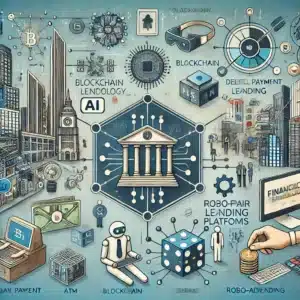Fintech are transforming the financial market.

Anúncios
Fintech, a contraction of financial technology, denotes innovative technologies designed to enhance and automate the provision of financial services. The evolution of fintech can be traced back to the late 20th century with the introduction of ATMs and electronic trading. Over the years, fintech has rapidly advanced, incorporating cutting-edge technologies like blockchain, AI, and big data analytics to revolutionize the financial industry.
Key Drivers Behind the Fintech Revolution
The fintech revolution has been primarily driven by increasing consumer demand for convenient and accessible financial services, as well as advancements in technology. Factors such as rising smartphone usage, internet penetration, and changing regulatory environments have also played crucial roles in fueling the growth of fintech companies worldwide.
Overview of Major Fintech Segments
Fintech encompasses various segments that cater to different aspects of financial services. These include digital payment solutions, blockchain technology, peer-to-peer lending platforms, robo-advisors, mobile banking apps, and more. Each segment addresses specific needs within the financial ecosystem, contributing to the overall diversification and expansion of fintech offerings.
Anúncios
Digital Payment Solutions
Types of Digital Payment Solutions
1. Mobile Wallets:
- Allow users to store payment information on their mobile devices for quick and secure transactions.
2. Digital Currencies:
- Virtual currencies like Bitcoin that enable peer-to-peer transactions without the need for intermediaries.
3. Online Payment Gateways:
- Facilitate online transactions by securely transmitting payment data between customers and merchants.
Impact on Consumer Behavior and Preferences
Digital payment solutions have revolutionized how consumers interact with money. They offer convenience, speed, and security, leading to a shift in consumer preferences towards cashless transactions.
Challenges and Opportunities in the Digital Payment Landscape
While digital payment solutions offer numerous benefits, they also present challenges such as cybersecurity threats, data privacy concerns, and the need for widespread adoption. Fintech companies are continuously innovating to address these challenges and capitalize on the vast opportunities presented by the digital payment landscape.
| Type | Description | Impact |
|---|---|---|
| Mobile Wallets | Store payment info on mobile | Quick, secure transactions |
| Digital Currencies | Virtual currencies like Bitcoin | No intermediaries |
| Payment Gateways | Secure online payment platforms | Streamlines payments |
| Cybersecurity | Data breaches and fraud risks | Need for strong security |
| Consumer Shift | Cashless payments preferred | Increases fintech demand |
Anúncios
Blockchain Technology in Finance
Fundamentals of Blockchain Technology
Blockchain technology is a decentralized, distributed ledger system that securely records transactions across multiple computers. Each block in the chain contains a cryptographic hash of the previous block, creating a secure and transparent network. The key components of blockchain include immutability, transparency, security, and decentralization.
Applications in Financial Transactions and Security
Blockchain technology revolutionizes financial transactions by enabling faster, more secure, and cost-effective cross-border payments. Smart contracts automate and enforce agreements without intermediaries, reducing transaction costs and processing times. Additionally, blockchain enhances security through encryption and consensus mechanisms, safeguarding sensitive financial data.
Potential for Disrupting Traditional Financial Systems
The potential disruptive power of blockchain technology lies in its ability to streamline processes, reduce fraud, and enhance transparency in financial systems. By eliminating intermediaries and increasing trust through decentralized verification, blockchain has the potential to reshape traditional banking, insurance, and investment practices.
Peer-to-Peer Lending Platforms
Understanding How P2P Lending Works
Peer-to-peer lending platforms revolutionize borrowing and lending by connecting individual borrowers with investors directly. Through online platforms, borrowers create loan listings detailing their requirements and risk profiles. Investors then browse these listings and fund loans that align with their investment criteria. This direct interaction eliminates the need for traditional financial institutions as intermediaries, streamlining the process and potentially offering more competitive rates for both parties involved.
Changes in Loan Market Dynamics
The emergence of P2P lending platforms has disrupted traditional loan market dynamics. These platforms offer borrowers an alternative to conventional bank loans, providing quicker access to funds and often at lower interest rates. Additionally, for investors, P2P lending presents a unique opportunity to diversify their portfolios beyond traditional asset classes, potentially yielding higher returns.
Benefits and Risks for Borrowers and Lenders
- Benefits for Borrowers: Borrowers can access funds quickly, often with less stringent eligibility criteria compared to traditional lenders. P2P lending also offers the potential for lower interest rates.
- Benefits for Lenders: Lenders have the opportunity to earn attractive returns on their investments, diversifying their portfolios beyond stocks and bonds.
- Risks for Borrowers: Borrowers may face higher interest rates if their creditworthiness is perceived as risky. Additionally, there is a risk of default, which could impact their credit score.
- Risks for Lenders: Lenders face the risk of borrower default, potentially leading to loss of principal invested. Diversification and thorough due diligence are essential to mitigate these risks.
Robo-Advisors and Automated Investing
Concept and Functionality of Robo-Advisors
Robo-advisors are automated platforms that use algorithms to provide financial advice and manage investment portfolios. They offer a user-friendly interface where investors input their financial goals, risk tolerance, and investment preferences. The robo-advisor then utilizes this data to create a diversified investment portfolio tailored to the individual’s needs. By leveraging technology and data analytics, robo-advisors streamline the investment process and make it accessible to a broader audience.
Impact on Traditional Investment Management
Robo-advisors have disrupted traditional investment management by offering low-cost solutions that are efficient and transparent. Unlike traditional financial advisors, robo-advisors eliminate human bias and emotions from the investment decision-making process. This results in more objective investment strategies and reduces the overall cost of financial advice. Additionally, robo-advisors provide real-time monitoring and automatic rebalancing of portfolios, ensuring that investments align with the investor’s goals.
Advantages and Limitations of Automated Investing
-
Advantages:
- Cost-effective: Robo-advisors typically charge lower fees compared to traditional financial advisors, making investing more affordable.
- Accessibility: These platforms cater to both seasoned investors and beginners, offering guidance and portfolio management services.
- Efficiency: Robo-advisors automate investment processes, saving time and effort for investors.
-
Limitations:
- Lack of Human Touch: Some investors prefer the personalized touch of human advisors for complex financial situations or emotional support.
- Limited Customization: While robo-advisors offer tailored portfolios based on inputs, they may not address unique circumstances or preferences.
- Risk Assessment Challenges: Algorithms may not always accurately assess risk tolerance or account for unforeseen market fluctuations.
By combining technological innovation with financial expertise, robo-advisors and automated investing platforms are reshaping the investment landscape, democratizing access to wealth management services, and empowering individuals to take control of their financial futures.
Mobile Banking and Financial Apps
Evolution of Mobile Banking
Mobile banking has evolved significantly over the years, transforming the way individuals manage their finances. With the widespread adoption of smartphones, banking services have become more accessible and convenient than ever before. Users can now perform a wide range of financial transactions on-the-go, from checking account balances to transferring funds and paying bills, all from the palm of their hand.
Enhanced Accessibility and Convenience for Users
The rise of mobile banking has democratized access to financial services, particularly for individuals in underserved or remote areas. Now, people can conduct banking activities without the need to visit physical branches, saving time and effort. This enhanced accessibility has empowered users to take control of their finances conveniently, irrespective of their location.
Features and Innovations in Financial Apps
Financial apps have revolutionized the way users interact with their money. They offer a plethora of features such as real-time account monitoring, budgeting tools, investment tracking, and even personalized financial advice. These innovations not only simplify financial management but also provide insights and recommendations tailored to individual financial goals and preferences.
Financial apps continue to evolve, integrating new technologies like artificial intelligence to enhance user experiences further. By leveraging data analytics, these apps can offer personalized recommendations, detect spending patterns, and streamline financial decision-making processes.
Overall, mobile banking and financial apps have reshaped the financial landscape, making it more user-centric, efficient, and accessible for a diverse range of individuals.
Cybersecurity in Fintech
Security Challenges in the Fintech Sector
Fintech companies face unique security challenges due to the sensitive nature of financial data and transactions. The decentralized nature of blockchain technology presents both opportunities and risks, requiring robust security measures to safeguard against cyber threats.
Protecting Financial Data and Transactions
Implementing strong encryption protocols, multi-factor authentication, and secure APIs are essential strategies for protecting financial data and transactions in the fintech industry. Regular security audits, penetration testing, and employee training on cybersecurity best practices are crucial to maintain a secure environment.
Emergent Technologies in Fintech Security
Emerging technologies such as biometric authentication, machine learning algorithms for anomaly detection, and decentralized identity solutions hold promise in enhancing fintech security. By leveraging these innovations, fintech companies can strengthen their defense mechanisms against evolving cyber threats.
The Future of Finance
Emerging Trends in Fintech
Decentralized Finance (DeFi)
- DeFi platforms are revolutionizing traditional financial services by offering decentralized and permissionless access to various financial products like lending, borrowing, and trading.
- These platforms operate on blockchain technology, eliminating the need for intermediaries and providing users with greater control over their assets.
Predictions for Financial Services Evolution
Integration of AI and Machine Learning
- AI and machine learning capabilities will continue to enhance personalized financial services, offering tailored recommendations and customized solutions based on individual financial behaviors and goals.
- Financial institutions are leveraging AI to streamline operations, improve customer service, and mitigate risks through advanced data analytics and predictive algorithms.
Potential Impact on Traditional Banking
Collaboration and Competition
- Traditional banks are increasingly partnering with fintechs to adopt innovative technologies and improve their service offerings.
- This collaboration fosters a hybrid model where traditional banking institutions blend digital solutions with their existing infrastructure to meet evolving consumer demands.







